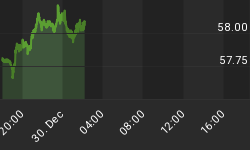As we should all remember, in early 2008, commodities were on fire as they moved up into their parabolic tops. From that top, commodities moved down in conjunction with equities. From the 2009 lows, stocks and commodities have been cyclically very similarly structured. But, that is now changing and the non-confirmation we are seeing in commodities is a problem for not only commodities themselves, but is potentially a warning of even deeper rooted economic issues.
Let's walk through the charts and I'll show you the problem. The first chart below is a weekly chart of the CRB index and the second chart is of the Dow Jones Industrial Average. The CRB bottomed in February 2009 and equities found their low in March 2009. From these lows both moved up into the next cyclical highs. In the case of the CRB, this high occurred in January 2010 and in equities it occurred in April 2010. These highs were then followed by the cyclical lows, which occurred in May 2010 for the CRB and in July 2010 for equities. Not perfectly in sync, but you can see that the cyclical movement is very very similar. From these lows the next cyclical advance began, which carried both the CRB and equities into the May 2011 highs. From there, both moved down in sync into the October 2011 lows that everyone has pretty much forgotten about. Anyway, it is from this point that the problem for commodities immerges. Note that from the October 2011 low, equities moved above their previous annual cycle high, but that the CRB hasn't. Also note that the CRB has begun to turn back down while equities have remained strong. This change of character has in turn created a non-confirmation between equities and the CRB. This is a warning on many fronts. This is telling us that not only are commodities themselves weakening, but that the inflationary forces are also waning. By default, this is telling us that we are seeing signs of deflationary forces and that perhaps the prop-the-world-up efforts by the Fed are losing their effectiveness.


In review, the CRB topped on July 3, 2008 with an intra-day high at 473.97. By December 5, 2008 the CRB had dropped 56 percent to 208.58 and the final low for the move occurred on February 24, 2009 at 200.16 for a total decline of 57.76 percent. In 2008, as commodities pushed into their highs, I warned of the top not only in the broader CRB index, but also in crude oil when everyone was looking for $200 oil. I was able to do so primarily as a result of my statistical based research. These warnings were made public here and on other websites, but more specific details were given to my subscribers at that time as to specifically what should follow in the wake of these anticipated tops and it unfolded almost perfectly in accordance with those statistical expectations. Unfortunately, very few listened because in spite of the statistical based facts, they we caught up in the emotional hype of that time. I am not saying here that there is another 50 plus percent decline coming in the CRB. But, I am saying that there is trouble in the commodity complex, which includes oil as well as gold and I am certainly not saying that large moves aren't in the cards here as there are now statistical and technical developments that must be overcome if the landscape is to change. The details of the developments in gold and the XAU have been covered in my last two monthly research letters and the developments there remain on track. Speaking of the XAU, for those who may not be aware of it, the XAU peaked in December 2010 and has since moved back to early 2010 levels. It seems that few are even aware of this, much less the statistical implications and opportunities.
However, the bottom line is that we are again moving into a very important cyclical hurdle or juncture for commodities. The key for the longer-term outlook of these markets is how well they handle this hurdle. It may ultimately prove that the recent weakness will turn out to be a buying opportunity. But, at the same time, it may also be marking the beginning of a much more negative setup. Again, we are at that juncture and it is the developments that manifest from here that will be our primary focus. The key, from my perspective, will be the behavior of the intermediate-term Cycle Turn Indicator, the statistics and the structural developments that unfold from here. Caution is advised.
















